
views
- Disinfect the roller with rubbing alcohol and wash your face before you do a treatment. Then, apply a serum containing niacinamide or hyaluronic acid.
- Roll the device across each area of your skin vertically, horizontally, and diagonally 2-3 times, avoiding your lips, eyes, and nose.
- Apply another layer of your skin serum after derma rolling, then a moisturizer. Expect to see a little redness and swelling.
- Keep your skin clean and protect it from the sun while it heals. Use a derma roller up to twice a week until you achieve the desired results.
Prepping Your Skin
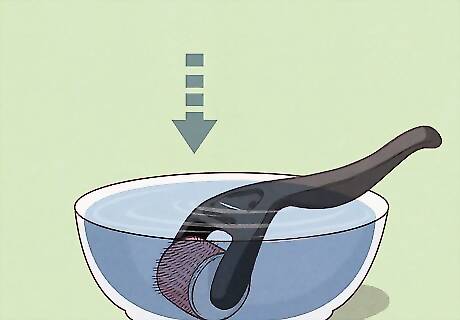
Disinfect the roller before you use it. Because the tiny needles will penetrate your skin, it’s essential to disinfect those needles first. Soak the roller in 70% isopropyl alcohol for 10 minutes Then, shake off the excess alcohol and let the derma roller air dry for a few minutes. 70% isopropyl alcohol is better than 99% because it doesn't evaporate as quickly.
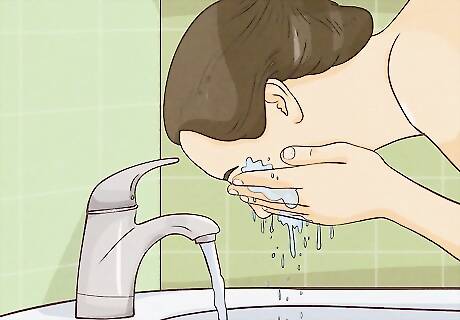
Cleanse your face. It's important to start with clean skin. Use a gentle cleanser designed for your skin type to thoroughly clean your skin. However, you don't want to start with anything too harsh, so skip facial cleansers with things like salicylic acid in them. Opt for something gentler. If you’re derma rolling an area other than your face, wash it with mild soap and water.
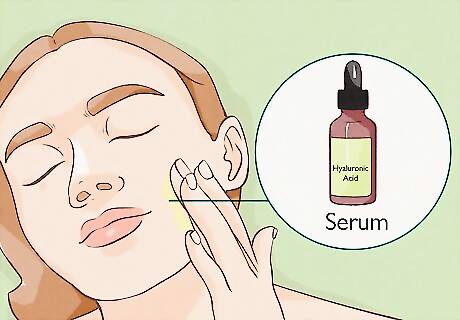
Apply a serum. Look for serums with niacinamide or hyaluronic acid to create supple skin and help fade wrinkles, scars, and dark spots. Put a small amount of your preferred serum on your fingertips and gently press it into the skin on your face. If you get the procedure done in a dermatologist’s office, they’ll apply a topical anesthetic 45 minutes beforehand. This isn’t necessary for derma rolling at home, though, because the needles are so much shorter and don’t penetrate as deeply.
Derma-Rolling

Roll vertically. Gently roll the device over your skin. Start on one side of your face and roll from top to bottom. Lift up the derma roller, and roll over the next area. Do each area 2-3 times. Don’t roll over your nose, lips, or eyes. Derma rolling at home shouldn’t hurt or draw blood because the needles are shallow. If it’s painful, don’t press as hard.

Roll horizontally. Repeat the process, rolling across your face horizontally. After each stroke, move down or up a little bit, and roll your skin until you've done the whole area 2-3 times.
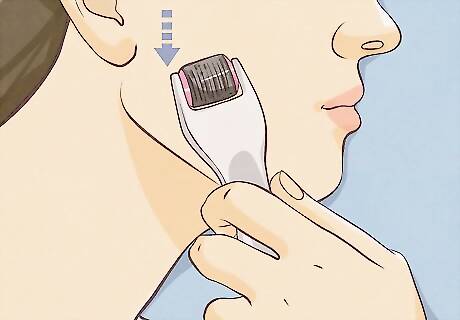
Roll diagonally. To finish up, gently roll the device across your skin diagonally 2-3 times. Lift up the device after each stroke, move it over a little bit, and roll it across the next area.
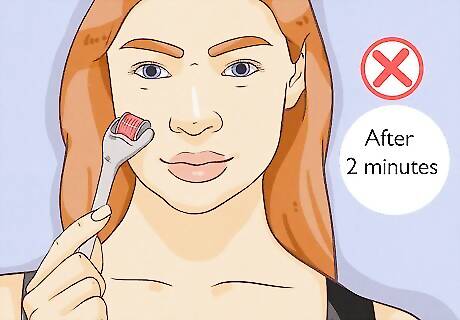
Stop rolling after 2 minutes, particularly on your face. You can overdo it with microneedling, especially on your face. Therefore, it's a good idea to limit each rolling session to under 2 minutes if you can.
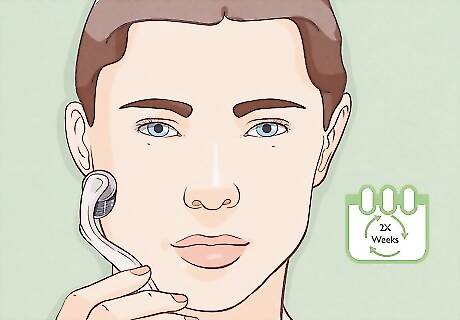
Use a derma roller up to twice a week. Experts suggest giving your skin time to rest and heal between treatments. You can derma roll at home 2 times per week if you’d like, or space out your treatments further. Some people only use this treatment every 6 weeks, for instance.
After-Care
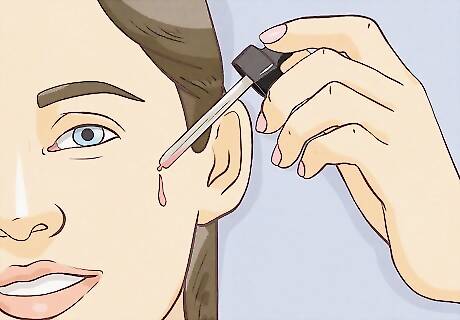
Apply another layer of serum. The tiny holes in your skin will allow the serum to penetrate deeper, making it more effective. Gently dab the serum onto your face.
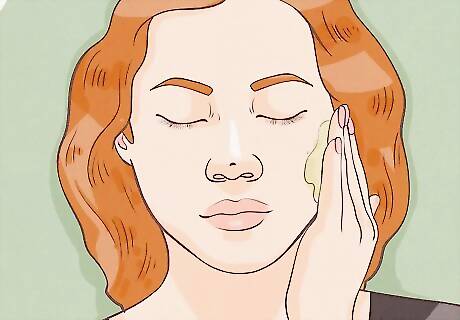
Hydrate your skin. Apply an emollient, or moisturizer, to soften your skin to help avoid irritation. Avoid applying a product with retinol or vitamin C after derma rolling, which can seriously irritate your skin.
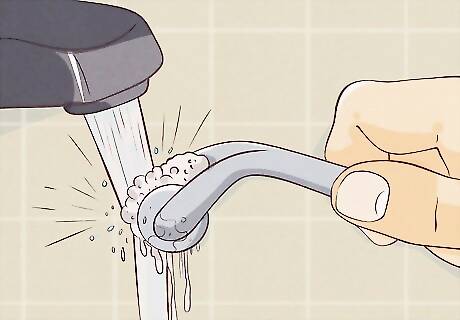
Clean the roller in dish soap and water. Wash your roller off using dish soap and hot water. Dish soap is better than other soaps at removing the tiny particles on your roller. Put the soap and water in a clean container, and shake the roller around in the water. Always clean your roller according to the manufacturer’s instructions.
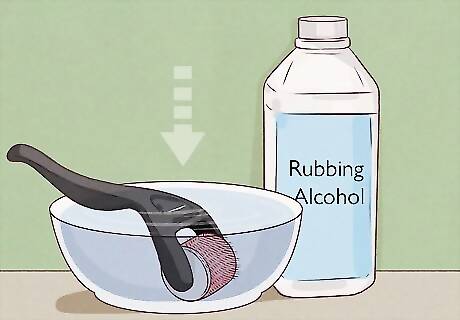
Disinfect the roller after using it. Spray the roller with rubbing alcohol. Then, store it upright so the needles aren’t touching anything. For best results, replace the roller head after using it 20 times.

Expect some redness and swelling. The side effects of microneedling include swelling, redness, and flakiness that can last for a few days. Feel free to apply makeup to your skin the day after a treatment. Avoid derma rolling if you have an active breakout, as it could worsen acne.
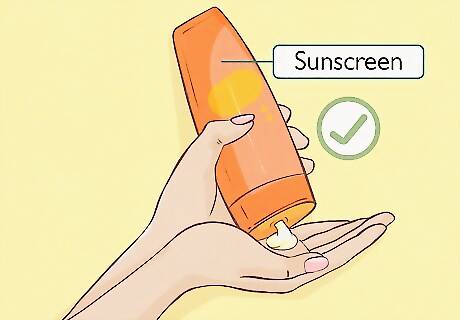
Keep your skin clean and protect it from the sun. Dermarolling essentially creates a bunch of tiny wounds in your skin. To prevent infection, wash the area regularly and avoid swimming or going to the gym, at least for a few days. Wear sunscreen if you plan to be outside, as well.
Best Derma Rollers, Benefits, and Results

Select a derma roller with needles that are 0.2 mm or shorter. While longer needles penetrate the skin deeper and may produce better results, you’ll need a dermatologist to perform the treatment with a medical instrument. To derma roll at home, look for a device with 0.2-mm needles. Several dermatologists recommend the Environ Cosmetic Gold Roll-CIT derma roller. The BeautyBio GloPRO Microneedling Regeneration Tool also comes highly recommended.
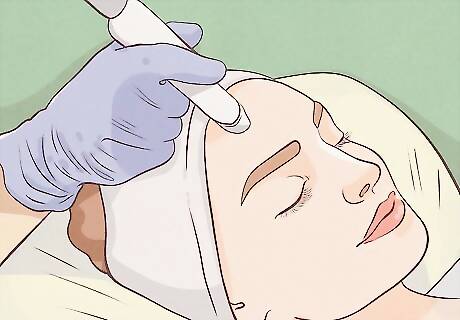
Use microneedling to treat acne scars and wrinkles. The FDA has approved microneedling by a dermatologist for minimizing the look of acne scars and wrinkles on the face and neck. They haven’t approved any over-the-counter products for use at home, though. Microneedling can also treat enlarged pores, dark spots, and stretch marks. At-home derma rollers don’t penetrate the skin as deeply as dermatological instruments do, so they’re best suited for exfoliation and delivering skincare products and serums to the skin. Derma rolling at home can also help shrink pores, reduce oil production, minimize fine lines and wrinkles, and reduce breakouts.
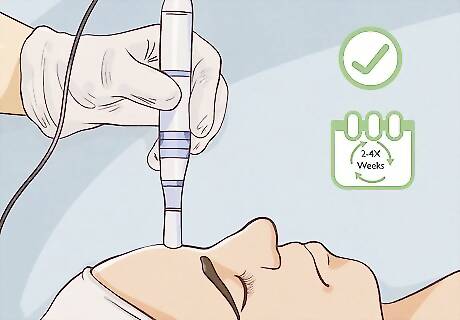
Plan to see results after 3-5 treatments. Microneedling works pretty quickly, but the results aren’t instantaneous. It will probably take 3-5 treatments, done every 2-4 weeks, for you to notice a difference in the appearance of your scars or wrinkles.

















Comments
0 comment